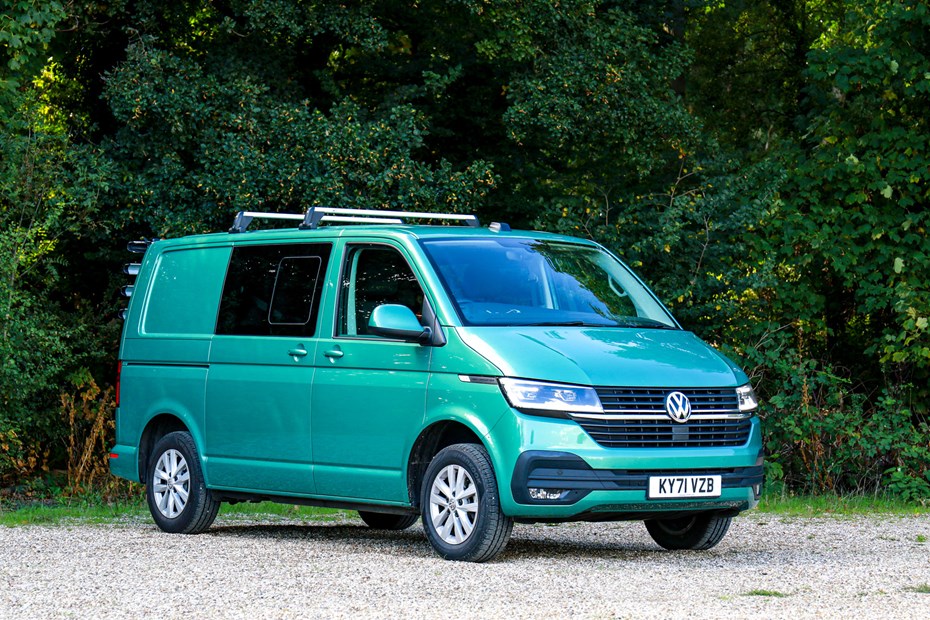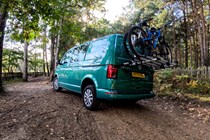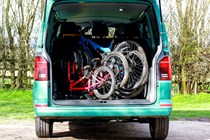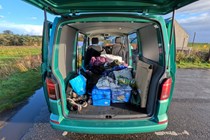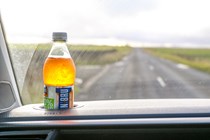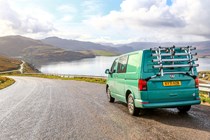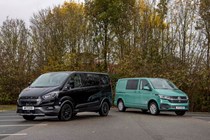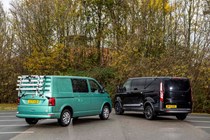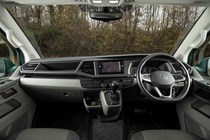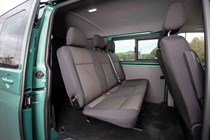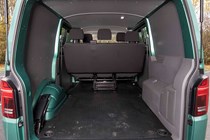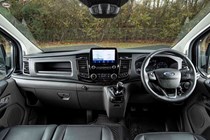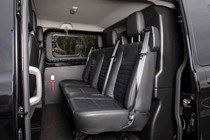Parkers contributor and Bauer Affiliate Operations Editor Adam Binnie is testing a Volkswagen Transporter Kombi to see whether this commercial vehicle is the ultimate transportation for an active, outdoorsy family. It’s a van with seats rather than an MPV, which means a rugged, mud-proof interior that fits four bikes with ease and can be cleaned out with a leaf-blower. Surely it doesn’t get any better than this?
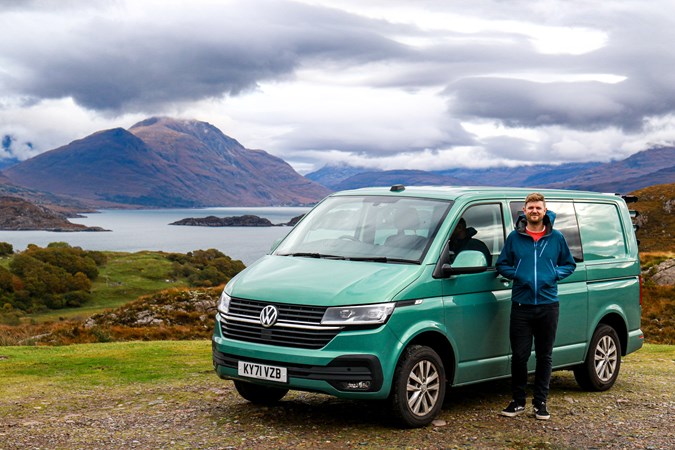
Report 1: Van Diesel
Introducing our T32 SWB Highline Kombi 2.0 TDI 150PS 7spd DSG
My colleagues have given me the nickname ‘Adventure Dad’, which if I’m honest, I have done little to deter. Because while I’m sure it’s meant in a semi-mocking way, it’s significantly less offensive than what they’ve called me in the past.
I think it’s because I quite like being outdoors, like one of those working dogs that has to live in the garden, and I’m always going on about it because I’m a chronic over-sharer. See, I just did it there.
Either way, I’ve been dropping (what I thought were) not-so-subtle hints in the office about running a van long-termer for a few years now, because as much as I like a V10 supercar, I’ve yet to find one that my mountain bike will fit into. Yes, I know SeaSuckers exist, but it’s not just one bike I need space for.
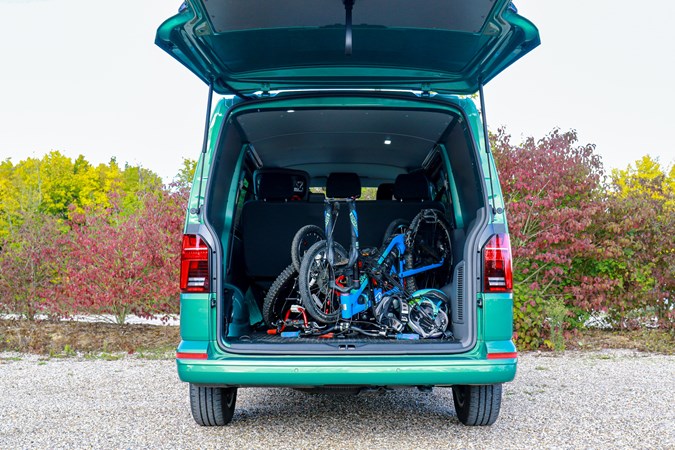
My wife and kids share the same hobbies and passions as me and while our four-berth tow-bar rack is large enough to carry all our bikes, it also made my last long-termer very long indeed. Also, you wouldn’t believe the boot space four inflatable paddleboards take up.
You may have already read my entry in CJ’s Ford Transit Custom Trail long-term report (I’ll wait while you catch up if you haven’t) where I tried to argue why his six-seater van was my ultimate family vehicle. So I won’t go over old ground by repeating myself.
What I will say however is that while the Ford ticked a lot of boxes, the fact it only had one sliding door and airbag made it a tricky sell overall. And so, as if by magic, I find myself in a Volkswagen Transporter Kombi with more of both things.
What sort of van is this?
This is what’s known as a Transporter 6.1 – it’s been around since 2019 and is a major facelift of a van that came out in 2015. Commercial vehicles have longer product cycles than cars, and the VW is due to be replaced in 2023.
It’s the most popular van VW makes by a long chalk and is usually the second bestselling medium van in the UK – behind its arch nemesis, the Ford Transit Custom. At the time of writing though it had also slipped behind the Vauxhall Vivaro.
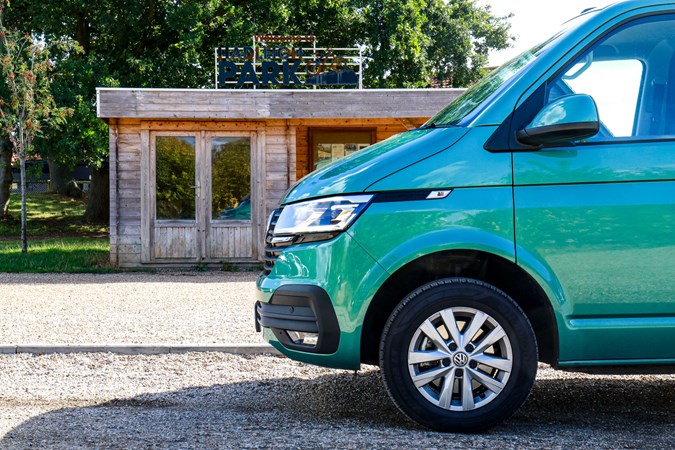
Sales figures aside, the Transporter has more of an aspirational image than either of those vans and is popular as both a working vehicle and as a lifestyle one. I will try my best to avoid using that word again on this page, but I suspect I’ll struggle.
Put bluntly – people buy these vans to carry mountain bikes and surfboards around in (hello) just as much as they do Euro pallets and copper pipe. This leisure image has been helped along by a connection to the historic VW Transporter – the two-tone, split-screen, hippy buses of old, and the evocative images it conjures up.
What on earth is a Kombi?
It’s still a Transporter van, just with a second row of removable seats and no (standard) bulkhead. You can add one in if you want, but in my mind, that makes it less flexible.
Where this gets a bit confusing is the fact VW sold the Caravelle alongside, which was also a Transporter with extra seats and no bulkhead. But the interior was suitably plusher than the van’s and the whole thing was pitched more as an MPV (remember those?) than a van with seats.
That variant no longer exists and has been replaced by the VW Multivan, which isn’t actually a van at all and is now based on a car chassis. Keeping up?
Volkswagen will tell you this has been done for all sorts of marketing reasons but look at the big picture – it’s confusing having two similar things on sale at the same time, and saying the Caravelle has a much nicer interior because it’s more car-like, kind of makes the Transporter’s sound a bit rubbish. Which it very much isn’t.
Finally, there’s the California, which is the camping-specific model. Let’s not worry about that for now.
So, the Kombi is an MPV like the Caravelle/Multivan in its ability to transport passengers, but because it’s still technically a van you get a harder-wearing interior (particularly in the load bay) and as a trade-off, lower speed limits on single and dual carriageways.
What powers this minty MPV?
Mine has a 2.0-litre diesel engine (actually, all Transporters do now) with a single turbo, meaning 150hp and the option to upgrade to a seven-speed DSG automatic gearbox. Not only does this make life easier, but an extra gear (over the manual’s six) means quieter cruising too.
In terms of positioning, it’s right in the middle of the range between the cheaper manual drivetrains and the more powerful auto, all-wheel drive ones at the top. That’s an option from this engine up, but this one is two-wheel drive.
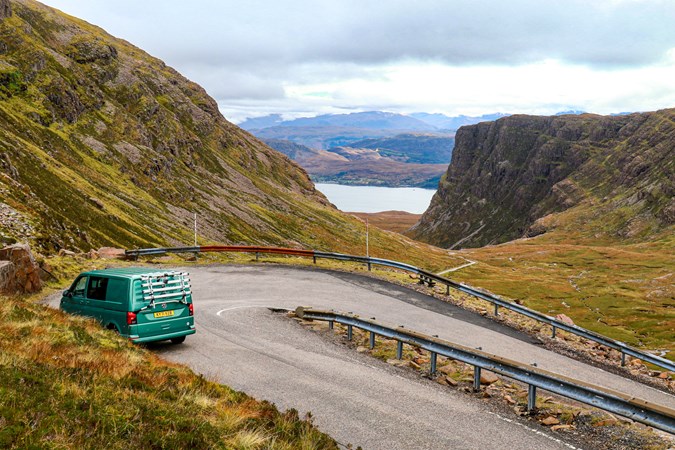
It feels faster than it is – 0-62mph takes 11.2 seconds, which isn’t anything to write home about, but short lower gearing means it fires off the line with surprising acceleration. The thing is, it’s usually got my kids or bikes (or both) on board, so I value smooth power delivery over outright pace these days, and the Transporter with its 340Nm of torque serves this up all day.
Electronic power steering was added to the conventional rear suspension (no boingy leaf springs here!) in the 6.1 facelift and that means a very car-like driving experience. It is a bit noisier than CJ’s Transit on the move though, potentially because it lacks a bulkhead, but also I’m told this is a bit of a Transporter thing.
The interior is way fancier than the T6’s, with a big central screen and loads of sharply designed lines – it’s not the most practical space though, with sparse dashtop storage and no lids to cover things up. I may be investing in some Velcro-backed storage boxes.
Highline tops the trim structure
Being top-of-the-line means you get loads of nice things like 17-inch wheels (although they don’t look it!), body-coloured bumpers, adaptive cruise control with speed limiter and auto lights and wipers. There are even some surprising car-like niceties like a heated windscreen and parking sensors front and rear.
This being an ex-press fleet demo van run previously as a long-termer means it comes with many, many options. About six grand’s worth, actually.
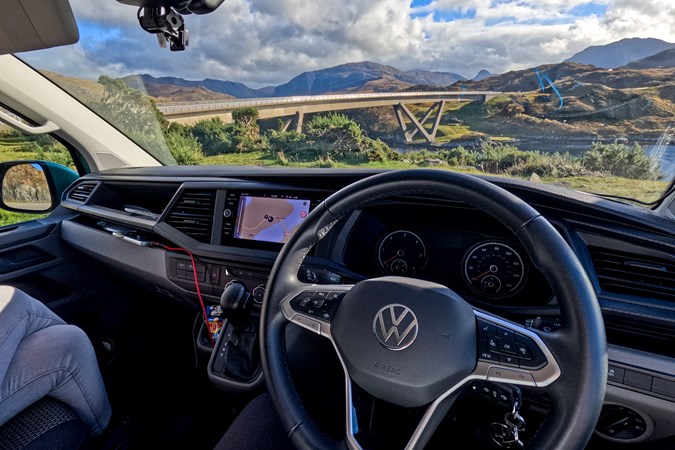
Options fitted to this van
• Carpet floor covering in cab (£126)
• Electronically controlled front air conditioning and second heating system in the passenger compartment (£342)
• Larger fuel tank – 80 litre (£78)
• Heated driver and front passenger seats (£396)
• Discover Media Navigation system with 8.0-inch screen (£1,416)
• Rearview camera (£306)
• LED headlights with LED daytime running lights and LED tail lights (£1,368)
• Tailgate without window (£78)
• Airbag – driver’s and front passenger’s side and curtain (£540)
• Driver’s side sliding door (£840)
• Washer fluid level indicator and heated washer nozzles (£66)
• Bay Leaf Green Metallic paint (£810)
Thing is, none of these feels extravagant (ok, maybe the paint) but the carpet in the cab makes a huge difference in perceived comfort in a family vehicle, while the second-row heating system makes a more tangible one.
The solid tailgate adds an extra layer of security and keeps prying eyes away from bikes left in the back, while the second sliding door means my kids can get in and out on the kerbside no matter where I park.
Finally, the larger fuel tank and additional airbags will come in handy on a long drive to see far away family, or on Scotland’s North Coast 500 (spoiler alert) – the former in a very real way, the latter more for reassurance should the worst happen.
Basically, this is how I would have specced it given the chance. So well done, previous owner.
What are your first impressions?
It’s brilliant – comfy, easy to drive, with masses of storage space in the back and a very upmarket image that in no way reflects me as a driver. But it’s nice to have either way.
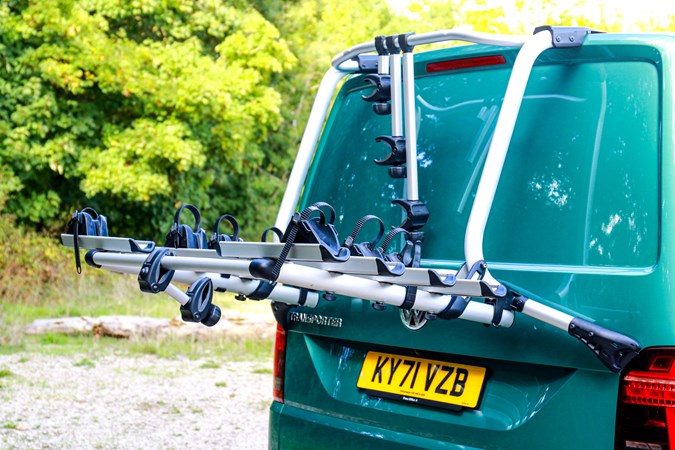
One thing I have noticed, I don’t seem to get let out of junctions by other van drivers as often as I have previously in commercial vehicles. It’s like they know I’m not a proper van driver. I think it might be the paint – or more likely the bike rack on the tailgate.
That might seem an odd addition when I’ve spent the last 500 words extolling the virtues of the Transporter’s interior size, but I’ve got some things planned for this van and I thought it would be a useful addition. More to follow.
Report 2: Transporter Kombi vs I.D Buzz, and why MPVs are cool again
Is VW’s most highly anticipated product, the electric I.D Buzz, any good for families?
A Kombi van like ours is now the ultimate lifestyle vehicle – sorry SUV drivers – but will it ever be as desirable as the original Transporter, or its electric reincarnation?
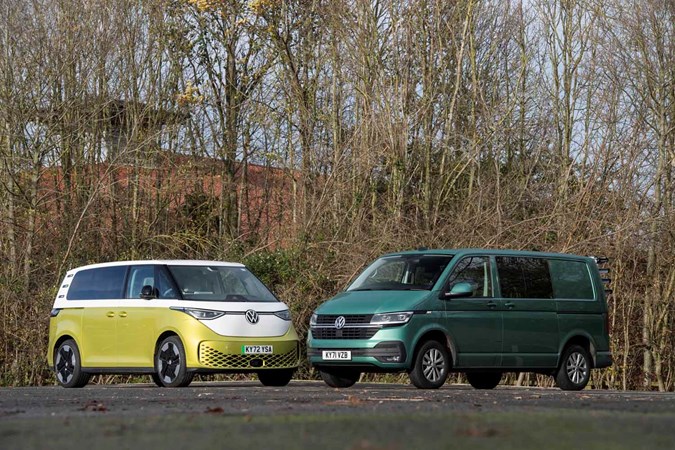
It might seem a bit premature to dive into a twin test in only the second update of this long-term review, but it’s a timely one. Because in case you hadn’t noticed, MPVs are cool again, and I’ve had a drive in arguably the coolest of the lot, the Volkswagen ID. Buzz.
You may wonder why all this MPV chat is relevant in a van review, but being realistic my Transporter Kombi is more MPV than commercial vehicle. Or at least it is in the way I use it, which is to load it up with my family and our hobbies. And that opens a whole can of existential worms.
The original “multi-purpose vehicle” was basically a big hatchback that dominated the 90s car market, with models like the Renault Scenic, Vauxhall Zafira and Ford Galaxy proving popular with family buyers and minicab companies alike. But be honest – compare the vehicle you see below with the two above – it is just a van with bigger windows, isn’t it?
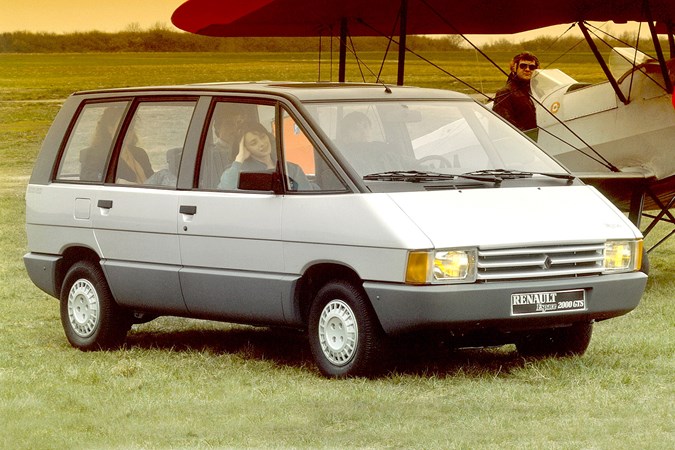
This class was largely killed off in the 2010s by the sports utility vehicle. Well, to be accurate, it was killed off by changing buyer priorities. I’m talking purely about new car sales here, I’m aware plenty of used MPVs still change hands. But basically, people who would buy new MPVs now buy SUVs.
Why? Lots of reasons, not least the projection of an active and adventurous lifestyle that necessitates the need for an off-road vehicle. You don’t get that in an MPV, which has more of a “hurry up we’re late for swimming class” image, and for reasons that escape me, that’s not as cool.
I’m not entirely immune to this phenomenon – in 2017 I ran the benchmark MPV, a VW Touran long-termer, and absolutely loved it. Then I swapped into a much trendier (and still seven-seat) Skoda Kodiaq SUV and decided I liked that more. Because it looked much cooler.

Thing is though, anyone who actually has an active and adventurous lifestyle runs into the same issue – most SUVs are no larger inside than the hatchbacks they’re based on. This is why my garage is full of roof rails and tow-bar bike racks. If getting an assembled mountain bike in the boot is a priority, then you need a van.
And so we cycle back to the original point (a mere 400 words later) – MPVs are cool again, and VW is currently at the cutting edge with the new Multivan (which CJ is running as a long-termer), and of course, the all-electric, reincarnated hippy bus of old, the I.D Buzz.
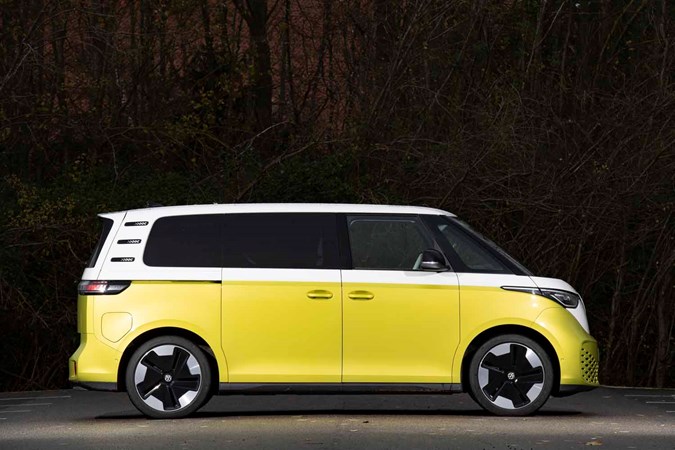
Although the I.D Buzz has a vast boot compared to a Golf hatchback, it’s nowhere near as practical as my van. But it does have plenty of passenger space for five, so if outright load capability isn’t as important as style, then here’s the vehicle for you.
Or is it? Because without meaning to overegg the elephant-shaped pudding, it costs £70,000, which is an absolutely vast sum of money, some £20,000 pricier than the more useful Transporter.
There’s no arguing that the interior is much more luxurious, with big squishy seats and fancy background lighting. But I didn’t find it as comfy as my van on a long drive, despite having the extendable thigh cushions the Transporter so sorely misses.
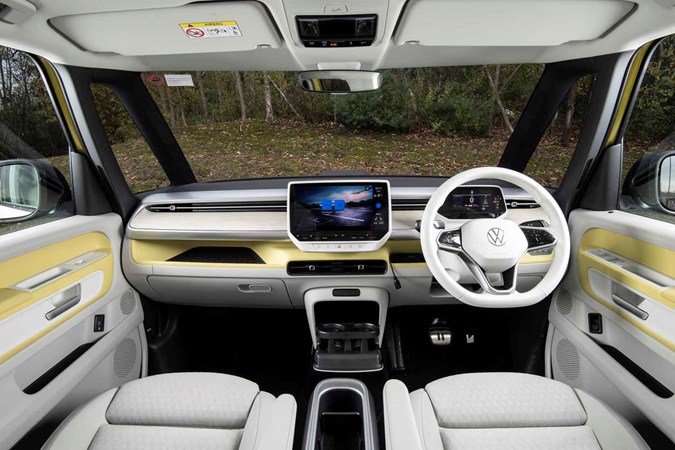
It’s quieter on the move, not just because of the lack of a diesel engine but because you’re better protected from wind noise too. I suspect that’s one of the reasons the door mirrors are so awkwardly stubby.
The fast acceleration and tauter handling make it feel much more carlike too, but big wheels give it a fidgety ride, and the windscreen is further away, which impacts visibility. You have two a-pillars with a quarter light between to peer through, making roundabouts and tight junctions slightly tricky.
This also means the dashboard is vast, but has no storage on top like in the van. There is an inbuilt shelf and better cup holder provision than the Transporter, plus a super-useful fold-away storage box between the seats, and the passenger gets a USB socket in their door pocket too. All small upgrades that add up to a much more modern design.
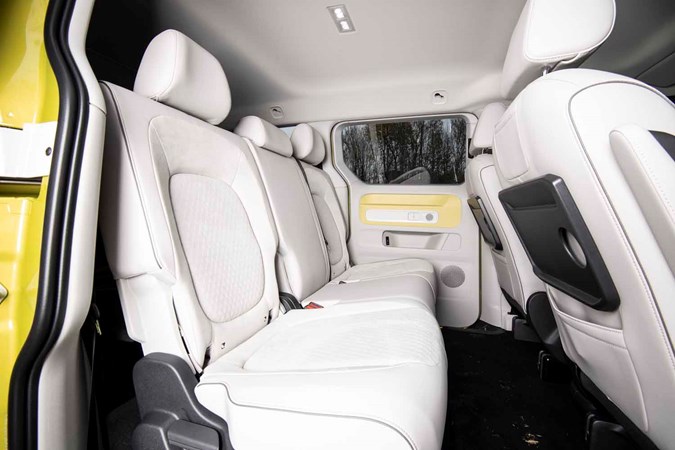
That’s before you account for the much bigger-and-nicer-to-look-at central screen, but like most VWs now most of the functions (including the air con) have been migrated to it and it’s less intuitive to use than buttons. I do like the light strip on the dash though, which flashes direction from the sat nav so you don’t have to look at the screen,
I shouldn’t really need to point this out but you get much less rear passenger space in the I.D Buzz (a van with a bench in it is always going to be more spacious) but the battery in the floor means it’s higher, and the roofline is lower, plus the seats themselves take up more room. They’re not removable either, which means no big tip runs like in my van, but they claw a point back for being split folding.
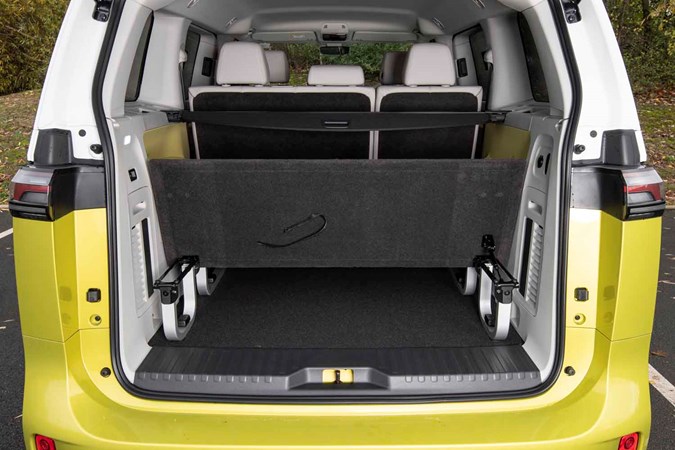
All-in-all the I.D Buzz is a vehicle of wildly swinging contradictions – it has a spacious and practical interior, that looks far too nice to transport anything in. it’s luxuriously quiet and comfortable to want to take away on a long drive, but without the battery range to do it. The I.D Buzz is an MPV with a cool image. It is the SUV buyer’s MPV.
If I was being extremely pragmatic, I’d point you in the direction of a Citroen eBerlingo like the one I borrowed from Richard not so long ago. Like the I.D Buzz it offers miles of range, loads of space for five and a big boot and costs less than half as much,
But if history has taught us anything it’s that there will be plenty of people for whom £70,000 is no barrier to I.D Buzz ownership and I’d imagine they’ve been falling over each other to buy one for months, if not years since it was announced.
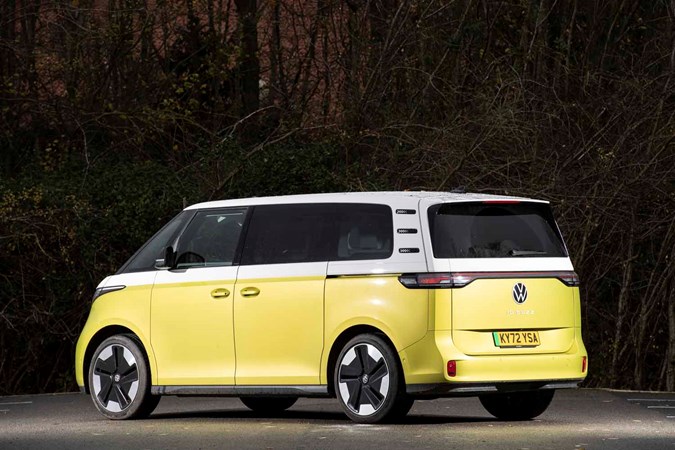
Case in point – when I was 20 years old and living in Devon, forcing a surfboard into an old Fiesta, the I.D Buzz would be just about the coolest thing in the world. And for driving the ten-odd miles to the beach every day I’m not sure I can think of a better vehicle. But for everyone else north of the Severn, that’s a bit of a niche use case.
Then again, I based my vehicle choice on its ability to transport my children and bikes at the same time. So what do I know?
Report 3: Let the load-lugging commence
What’s the Transporter van like at being a van?
Family duty aside, our Kombi van needs to be good at carrying big, heavy equipment, and luckily Tom needs to move an entire stage
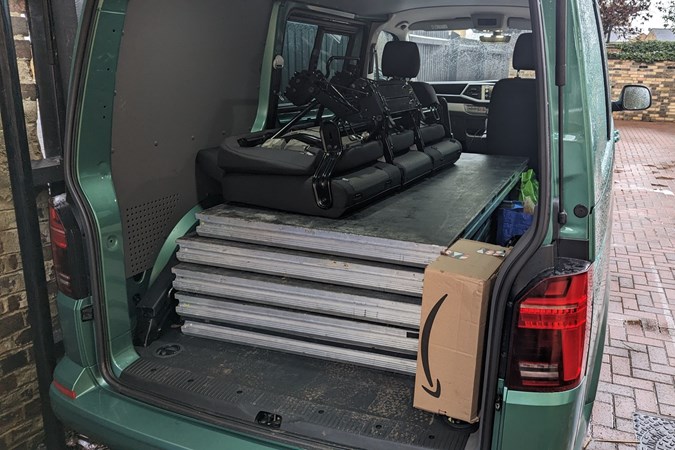
While Adam’s been using his van for numerous familial and lifestyle pursuits, he’s also been fighting off a bulging inbox full of people asking to use it for more conventional ‘van’ tasks. I was lucky enough to ask at the right time, and so have found myself calling on the Transporter’s considerable carrying capacity for two weekends so far.
I sing with Peterborough Male Voice Choir, and while usually all we need are our larynxes, there are often occasions where bulky equipment needs moving too. The first such occasion was getting some staging equipment way up north, for a recording session with the Grimethorpe Colliery Band.
What’s it like carrying stuff in the VW Transporter?
This necessitated removing the rear seat bench to give us an uninterrupted 2m of loading length. I will say, this is definitely a two-person job – the bench is heavy, bulky, and doesn’t really have anywhere too obvious to grab it. It’s a bit of a pain to clip back in, too, though I imagine with practice this would get easier (I’ve done it by myself once and would not recommend it, and neither would my physiotherapist – Adam).
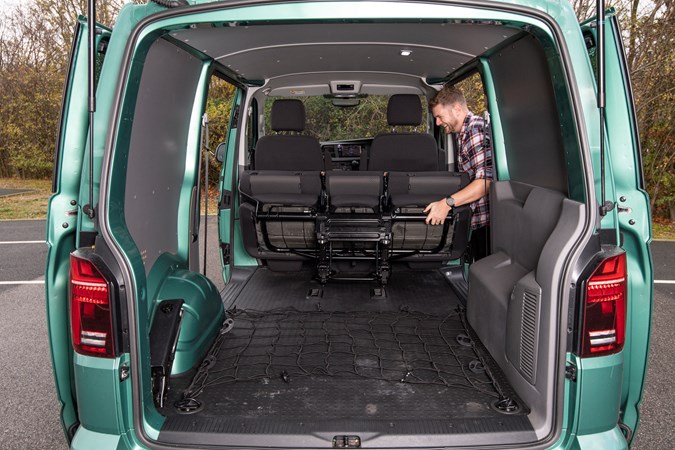
The drive north was uneventful – vans are as relaxing to drive as most cars these days, and the Transporter’s LED headlights, Android Auto connectivity and heated seats ensured an easy trip. As for loading and unloading, it could hardly have been easier – and I really like that this model has a lift-up tailgate rather than individual barn doors at the rear. I know it takes more space to open, but I always worry about barn doors swinging around and clonking the car I’m parked next to. The tailgate makes it look rather more like a posh people-carrier than a van, too.
The next time I called upon the Transporter’s talents was for our annual Christmas concert. This time, staging was taken care of with a Luton van, and the Transporter took on all of the smaller items – Christmas trees with which to decorate Peterborough Cathedral, urns for interval drinks, literally hundreds of mince pies and all the other assorted detritus that nobody realises goes into staging a performance.
I left the rear seats in for this one and once again, the van performed admirably.
Any problems?
Well, disaster struck after my first trip in the Transporter and a jug of milk managed to split, spilling itself across the interior. No worries – this Kombi has a wipe-clean load floor, and a quick trip to the hand car wash later it had been pressure-washed and sorted. Or so I thought – until a couple of weeks later, when I got back in the vehicle and it smelled just faintly cheesy…
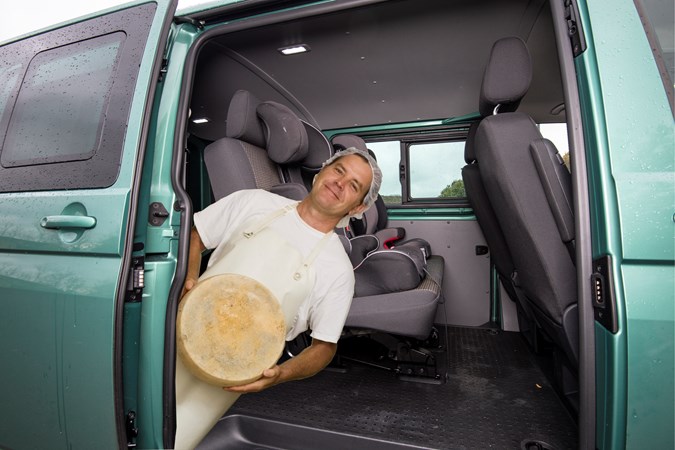
This could be my imagination, or something entirely different – Adam has two children, after all, and we all know they’re capable of spreading any number of different oozes across any flat surface of a car interior. But what I suspect is that some milk may have squeezed its way under the floor. Oops.
None of my other complaints are massive problems, per se – more niggles or ‘nice to haves’. I felt that the 150hp engine felt a little underpowered for a vehicle that’s approaching £50,000. I’d would have loved it if the rear seats came in two parts – a 60:40 split would give so much more flexibility with that rear space – and better cupholders would also be appreciated.
Generally, though, I was mightily impressed with this Kombi – and I can see why Adam’s adoring having it as the go-anywhere and do-anything family bus of dreams.
Report 3: Shipping out
Can I borrow your van to move house?
Senior Staff Writer Luke Wilkinson has just moved house and Adam graciously lent him the Transporter keys to save him renting a Luton van. Unsurprisingly, it works well as a packhorse – but there are a few problems with the cabin that means it doesn’t load as well as its commercial sibling.
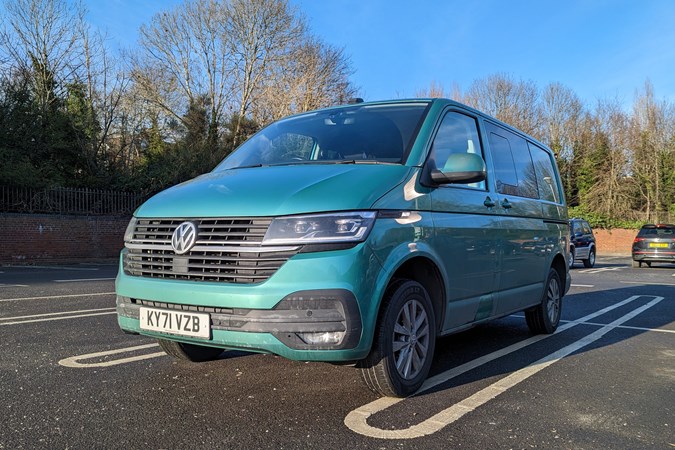
London is an awful place to live. Our old flat in Bounds Green was more mould than it was bricks and mortar, so my girlfriend and I packed up and moved to healthier property around 100 miles north.
Our move provided the perfect opportunity to push the limits of the Transporter’s ability. In the space of just one week, we needed to empty our old flat of all our belongings and make a couple of trips to IKEA to replace the furniture that was ruined by the mould in our London flat. In short, our mad dash would be a condensed test of the van’s comfort, fuel economy and carrying capacity.
Before I could throw the first box into back of the van, though, I needed to get the rear seats out. As my colleagues have already mentioned, they weigh about the same as a small asteroid. It was a three-man job to liberate them from their mounts – Ryan Gilmore and I hauled them into a storeroom in the office while Adam opened doors and laughed at us.
Once they were out, though, I was struck by the sheer amount of space available. My girlfriend, Julia, was adamant that it would take at least four trips to completely empty our old flat, but we managed to get it done in two, thanks to the Transporter’s cavernous cargo bay.
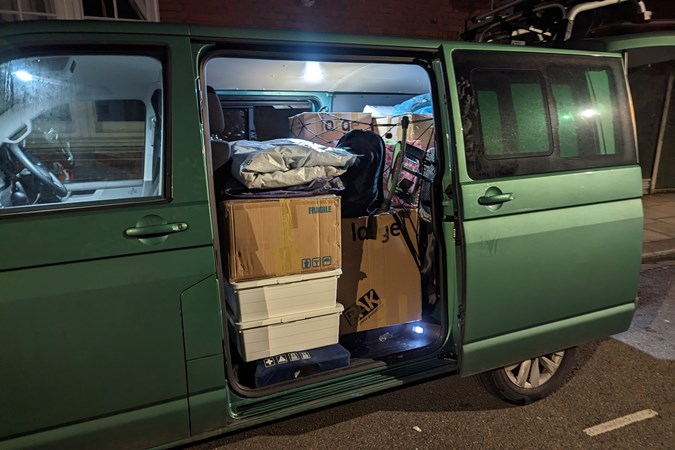
However, I have a few gripes. First off, the rear bench clips into four quick-release cups which sit proud of the floor. That means, when you load the rear up with clobber, you need to stack your boxes around the mounts to allow them to sit flat, which means you can’t use the space efficiently. You also can’t slide longer items (like a flat-packed IKEA wardrobe) along the van’s floor without stoving it into the clip.
There aren’t enough tie-down points, either. The hooks on the floor are great, but I’d have liked to see some on the sides of the van too. If you’re carrying a lot of cargo, you can’t always access the tie-down points to lash it down with the luggage net. I found myself forcing the luggage net hooks into the seat belt brackets, which is awkward and probably not all that safe.
It’d be handy to have an extra pair of hooks at the top of the B-pillars behind the front seats, too. That way, you could create a barrier between your cargo and your head with the luggage net so, if you need to brake hard on the motorway, you don’t get KO’d by a rogue box of crockery.
Awkward loading aside, I was impressed by how comfortable the Transporter was on the motorway. I must have covered around 500 miles over the course of the week – and the Volkswagen’s double-armed captain’s chairs kept me comfortable. Unlike every van my Dad owned, the Transporter’s seats have lumbar support, which means you don’t curl up like a shrimp on a longer journey.
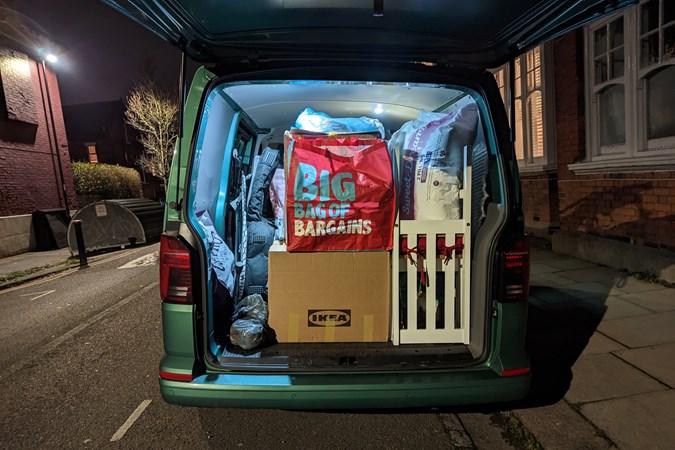
The Transporter’s ride is more composed than almost any commercial vehicle I’ve experienced. Like most vans, it’s noticeably better when the rear is full of cargo – but the rear axle doesn’t bounce over potholes like it’s solid-mounted.
It does get floaty in motorway crosswinds, though. You need to steer into the wind a little to keep it tracking true when you’re running empty – but that’s a complaint that can be levelled at any van. And the trade-off for trucking without any cargo is vastly improved performance.
The Transporter’s quick. It has 340Nm of torque, which is only 5Nm less than you get in the Ford Focus ST hot hatchback. In-gear acceleration is strong, which makes overtaking a breeze. Because I’m a 10-year-old at heart, I also found out that if you snap the throttle shut when climbing a hill with a fully laden cargo bay, the labouring turbocharger will flutter like a Group B racer. It’s great fun.
I was also rather grateful for the van’s optional 80-litre fuel tank. It gives you a range of around 600 miles if you baby the throttle, which meant I only needed to fill up once during the week. That fill up was well over £100 – but you can excuse it if you’re on a tight schedule. The last thing you need in a time crunch is to be constantly hunting for fuel stations.
Second opinion
The Transporter is a great alternative to an SUV for outdoorsy families – and, on the odd occasion you need to carry bulky stuff, it can do the job around 98% as well as a conventional van.
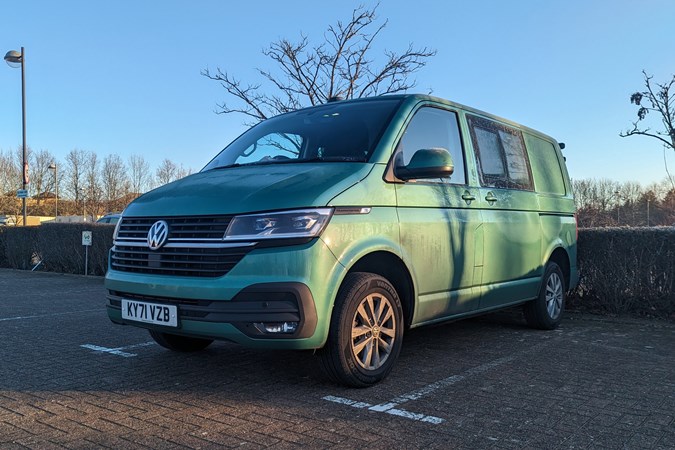
The problems highlighted above will probably only irritate the seasoned panel van driver. If you’re stepping up from a smaller MPV, you’ll appreciate the sheer amount of space more than you’ll lament the minor practicality foibles.
Just weigh up whether the price is worth it before you buy. Our Transporter is excellent, but it costs £53,367 as tested, which is an awful lot for a van with windows. Strip some of the options off and you can cut that price back slightly – but it still doesn’t represent as good value as an equivalent Ford Transit. Spec a Transit up the same level as our long-termer and you’ll only pay around £47,000. That’s certainly food for thought.
Report 4: Transporter Kombi vs Ford Transit Custom, the old rivalry
The absolute van OG – how does our Transporter stack up against it?
Ruthlessly benchmarked, rarely bettered, the UK’s best-selling vehicle in 2022 has nothing to prove, but fancied squaring up to our VW van anyway
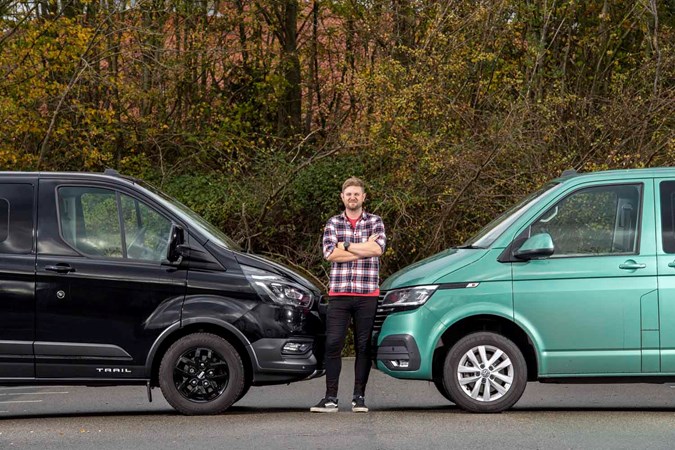
We’ve had some great automotive rivalries over the years – Ford and Ferrari, Ford Focus ST vs Honda Civic Type R, and even the battle for the UK’s top-selling car, between the Vauxhall Corsa and Ford Fiesta.
Notice a theme? For some reason, everyone has beef with the Blue Oval, and it’s no different in the van world. My VW Transporter long-termer is pretty docile until you show it a picture of a Ford Transit Custom, at which point it fluffs up its carpet and emits a low-pitched growl.
Thing is, doing a scientific analysis of these two great vans is largely pointless because the verdict has already been decided by the van-buying public, who overwhelmingly flock to the Ford. It was actually the best-selling vehicle of any kind in 2022. Not just commercial vehicles.
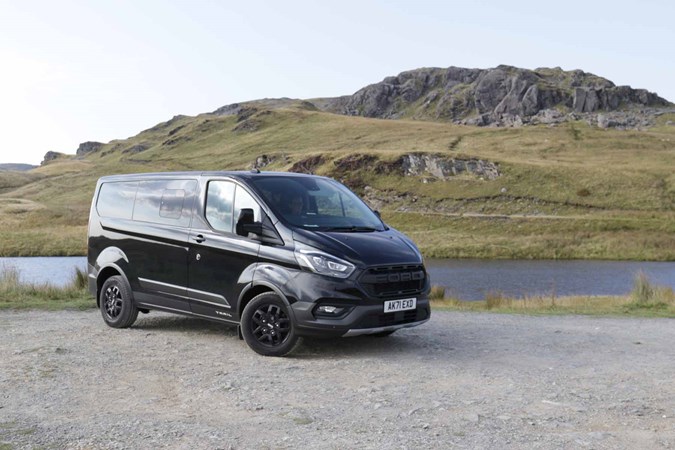
Also, there are as many different specs and configurations as there are use cases, so it’s not really possible to do a forensic examination of the range without falling back to that useless “well, depends what you want it for really” verdict.
But CJ has a Transit Custom Trail long-termer with the same number of seats as mine (you may remember reading about my holiday in it) so it’d be a bit of a missed opportunity if I didn’t get them together and work out which I like best, wouldn’t it?
First test, exterior styling
This may be the least pragmatic metric in what should be a very pragmatic test, but the Transit looks better than the Transporter from the outside. It’s the shoulder line that goes from the headlight diagonally upwards towards the taillights, and the blistered rear arch, that does it.

The Transporter looks sharp, there’s no denying it, but it’s also very straight-laced. The Transit has popped its collar up and is about to tell a rude joke. And for some reason that’s better – don’t ask me why.
Interior storage
I’ve deliberately picked another area where the Ford wins, purely because of how much the Transporter’s lack of storage annoys me. It’s a massive vehicle with hardly anywhere to put things.
That’s like moving into a palace only to find out there’s just one gigantic room with no shelves or cupboards, so you just have to pile all your stuff up in the middle.

The Transit has three dash top storage buckets to the VW’s two, plus three cup holders and two bottle holders. The Transporter has two cup holders and one smaller tray so you’d better hope you’re not all thirsty at the same time.
Interior comfort
Here’s where the German van starts to claw back some ground because it is much nicer inside – objectively, subjectively, definitely. It also has comfier seats and two armrests each on the front chairs.
Somehow it feels more spacious too, that could be due to the Transit’s double seat vs the Transporter’s captain’s chairs, but either way, you can’t slide forwards or backwards in the Ford.

The bulkhead in the Transit means it’s generally warmer in there and quieter on the move too, but less flexible if you want to transport something long, like one of my long term updates. It does have better door mirrors though, great big ones with small blind spot sections at the bottom.
You do have to hold your finger down on the passenger window button to open it rather than just jabbing it once however, and that is absolutely ridiculous in this day and age.
Where it counts – the load bay
Ford gives you barn doors as standard, VW a tailgate, which as we all know is better for lifestyle pursuits where you might have to shelter under when it rains. Less good in supermarket car parks though.
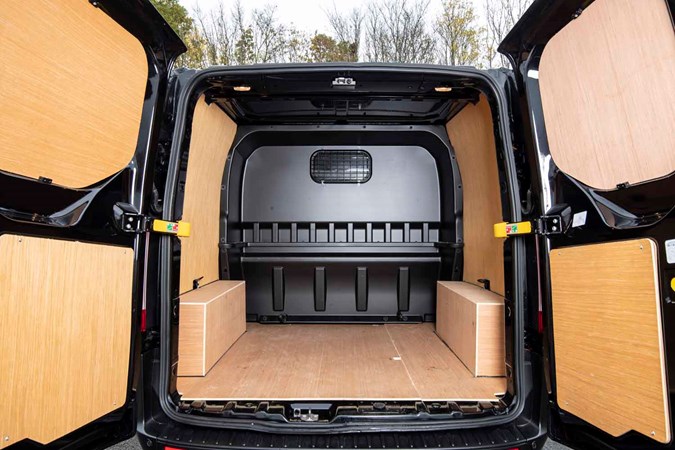
The Transit seems to have more wheel arch intrusion but that could be down to the ply lining. There’s no wood in the Transporter, but the floor is made of a big squashy marshmallow, which is kinder to expensive bikes and also stops things sliding around.
What about the way they drive?
Those sporty looks on the outside of the Transit are backed up by much faster steering and a generally sharper drive. The VW is suitably more relaxing to drive but less fun.
It also has a quieter engine, that’s for sure, but the Ford does deliver its power in one delightfully whooshy lump, which is a bit of a laugh really.
Which would you pick?
Well, it depends what you want it for really. I’d have the VW though, albeit it in Sportline trim.
Report 5: Bikes, boot, back seats, that sort of thing

I’ve pitched this van as the ultimate transportation for my family and hobbies, but how does it actually stack up?
In which we investigate the basic van and the options added to it, in order to see what’s worth it and what’s not
Size matters when it comes to family transport, and it’s funny how quickly your priorities change as babies and toddlers grow into small adults. I never thought I’d be so evangelical about a panel van, and yet here we are.
Covid and my working pattern has changed things too. Previously I had at least ten solo car journeys a week to and from the office in which to enjoy fast or fun cars, now it’s less than half that. If I’m driving these days, chances are I’ve either got my bikes or my kids on board, and either way that means I’m going slow.
Case in point – I borrowed Richard’s Fiesta ST while he was moving house in my van. Don’t get me wrong, I had one very memorable drive in it, but that was roughly 3% of the total time I had it. The rest was spent in traffic or on the motorway, or telling my daughter we couldn’t go the bike park that weekend.
Big boot > big engine
This realisation has crept up on me slowly over the years and it’s one my friends and colleagues don’t really get. I still like driving a fast, impractical car from time to time, but mostly I’d rather be in a van.
Two things in adult life stress me out more than they should – planning things and remembering all the stuff I need for a certain activity. Add kids into the mix and this gets even more complicated, because they have their own set of completely different things you need to remember too. Snacks, a change of clothes, a very specific travelling teddy companion, the list goes on, and is limited by the size of your boot.

The solution to both things is a colossal load space. Fancy a scoot round the skatepark followed by a picnic and a bike ride around a lake? Great, let’s go. What if we need this thing or that? Just chuck both in.
VW Transporter optional extras for family use
Assisting here is the £78 solid tailgate – no glass means prying eyes can’t spot the potential stealables concealed within the van, but factor in another £306 for the rear view camera to avoid reversing into bollards. Another £78 (weirdly) gets you an 80-litre fuel tank, which means you basically always have diesel.
Inflating the price somewhat more is the driver’s side sliding door (£840) but that should be considered an essential item if you’ve got kids on board. Now you can park whichever direction you like and ensure one of the doors will be on the kerb. Also, do you know how annoying it is having to circumnavigate a van to the passenger side when the door hasn’t been shut properly, and now won’t open because you’ve got the child locks on? I’ll tell you – really annoying.
Equally important for family use are the driver’s and front passenger’s side and curtain airbags (£540) for reasons I shouldn’t need to explain, and the £342 rear space heater. It gets really cold in the back of a van and unless you want the front vents set to thermonuclear in an effort to warm the whole thing up, you’ll want an independently controllable heat source in the rear. Also it’s great for drying muddy shoes.
Pricy tech that makes life easier comes in the form of the larger Discover Media Navigation system with 8.0-inch screen (£1,416) and LED headlights/daytime running lights/tail lights (£1,368). I say you need them, you can make your own mind up.
Finally there’s the nice but not essential stuff – cab carpets (£126) and heated seats (£396) – both of which make the van cosier in the winter, but you could live without.
What’s the second row like?
Huge – my kids can’t reach each other, or us, and this is an absolute game-changer. My daughter also can’t reach her seatbelt to put it on either, and while this is a bit of an inconvenience, it’s massively offset by the point above.
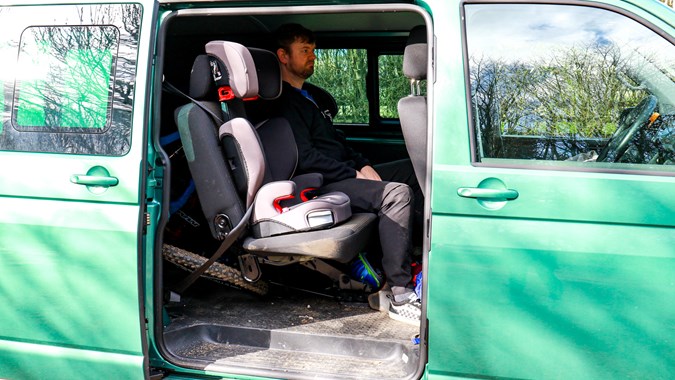
For added practicality it’s worth pointing out an adult can easily fit between two bulky children’s car seats (but why on earth would you?) and there’s head and legroom for days. There are only Isofix mounts in the outer two, which feels like a bit of a missed opportunity.
It’s also quite boring back there, the nicer cabin trim in the front ends abruptly and while there are pop-out windows, there’s not much else to differentiate between the Kombi and just sticking some patio furniture in a panel van.
Family cars usually have some nods to comfort in the rear, either window blinds or some actual storage pockets, maybe even a fold out table on the seat back. The van has none of this, which means improvising with some plastic containers stuck to the floor with Velcro.
What about mountain bike transportation?
This is where the Transporter scores a huge win because we can get all four family bikes in the back, fully assembled, plus four on the tailgate and another two on the roof.

Plainly this is more bike storage than anyone needs but what it represents is options – we might start off with them all in the load space, but on the way home the muddiest bikes can be attached externally.
Unlike other rear-mounted racks I’ve used, you can drive off-road with bikes on the back of the Transporter with no issue. My tow-bar outfit would quite regularly turn into a ground anchor in the undulating dirt car park where I like to ride my bike.
The rack is super simple, it just folds down when you need it revealing four slots for wheels to be clamped into and four arms to hold a spot on a bike frame. You do have to lift your bike a bit higher that a tow bar rack, but not as high as a car roof. It’s also really good for drying wetsuits on.
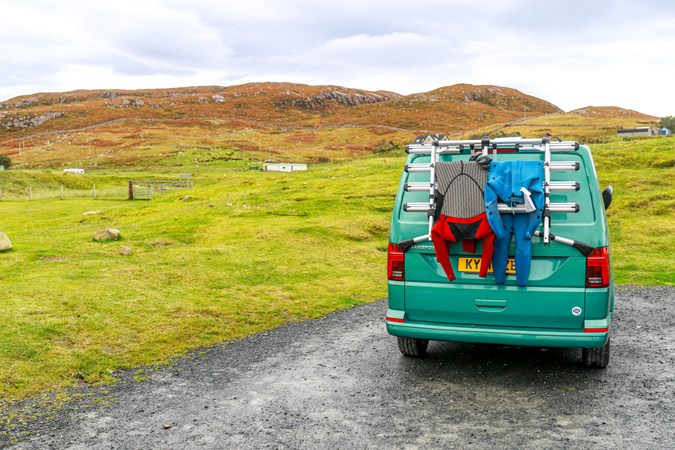
When it’s just me riding of course, I can just slot my massive mountain bike in diagonally. The load space is so huge the bike actually has to be tethered to the second-row seats to stop it rolling around, and I’ve wrapped a couple of bungee cords around the headrests to this end.
If you need to get changed before or after the ride then the Transporter works really well as an improvised private space, either in the rear of the van or up front – just bear in mind you can’t easily move between the two thanks to the huge rear bench, so if you start getting dressed in the rear and then realise your trousers are in the front, you’ve had it, basically.
There is also nowhere to store anything else in the back, so your pump or toolbox is going to rattle around endlessly, while your helmet has to be clipped around a seatbelt or headrest post. I’ve seen aftermarket solutions for this, with one of the walls lined with pockets to store things in, and I think this becomes almost essential.
And road bikes?
Funny you should ask, because at the start of 2023 Richard borrowed the Transporter to support a charity cycle ride organised by four of Bauer Media’s fittest (and nicest) cyclists, in memory of a much-loved colleague, Ben Stamp, who had passed away.
Joined by Tom Wiltshire in CJ’s Multivan, the Transporter acted as a support vehicle, ensuring the cyclists and bikes made it to Lancashire to embark on a 111-mile coast-to-coast ride, and following the route in case of incidents and for moral support.
Richard said: “With riders ensconced in the Multivan’s luxurious seats, the Transporter carried the super-light carbon-fibre bikes (and my 33kg eBike, which ended up not being used) inside given their value – though the bike rack on the tailgate would have been ideal if we had to pick up one rider and move a bike quickly.
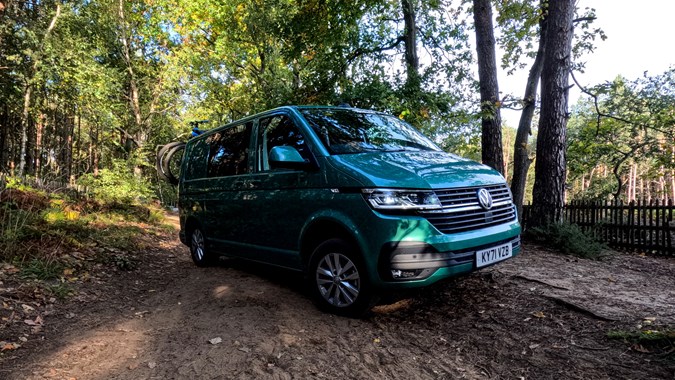
“The only downside of the crew configuration (apart from the mind-bending weight of that rear seat when you remove it) is a lack of tie-down/securing points, we deployed a creative stacking setup with bungee cords.”
Echoing my own criticism of the lack of storage in the back, Richard also pointed out the lack of tie down anchors on the walls. You get one in each corner of the loadbed and that’s it.
He added: “Your own van would, of course, be customised for the purpose, so it’s not a big issue, but it surprised me how little provision there was on the side of the van for securing loads.
“The ride went brilliantly – 6hrs, 45 minutes and target achieved for fundraising – and for the drivers, the route across the Yorkshire Dales proved entertaining, highlighting the excellent handling of the Transporter and the benefits of a high viewpoint when driving in such scenery.
“Returning to cars, aside from the slight ‘boom’ at speed and lack of finesse on door trimming and speakers, meaning the audio system has plenty of rattles and buzzes, it’s clear just how good the Transporter remains as, well, transport.
“It rides well, handles bends with excellent feedback and grip, and is comfortable (though the Multivan driving position is better and more adjustable, highlighting its improvements as a passenger van over the Caravelle).
“Next to my recently-acquired 2002 Mercedes-AMG ML 55, I think the van would be quicker through bends and definitely has more positive, direct steering and brakes.
“It’s clear why VW Transporter owners love, and personalise their vans so much. And how much owning one can win friends* and influence people!”
*which is good because you’ll need at least one to move that seat…
Report 6: A lap of the North Coast 500
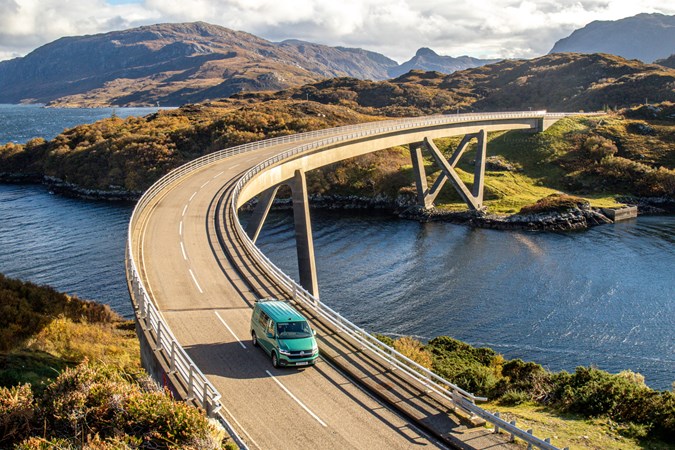
Every summer the NC500 is awash with campervans and motorhomes, but what’s the best vehicle to take if you’re staying in hotels?
We did 1,500 miles in the VW Transporter over the course of a week, here is one word for every mile explaining why it was the perfect vehicle for the job
If a camel is a horse designed by committee, then the VW Transporter Kombi is a vehicle designed by the same committee to take on the North Coast 500. Bear with me.
Firstly, a brief explanation – the NC500 is a road route through the stunning Scottish highlands, starting in Inverness and then hugging the shoreline in a big circuit through some of the UK’s most beautiful scenery. I’ve driven small sections of it on car launches and holidays, but never the whole thing, and it’s been on my to-do list for years.
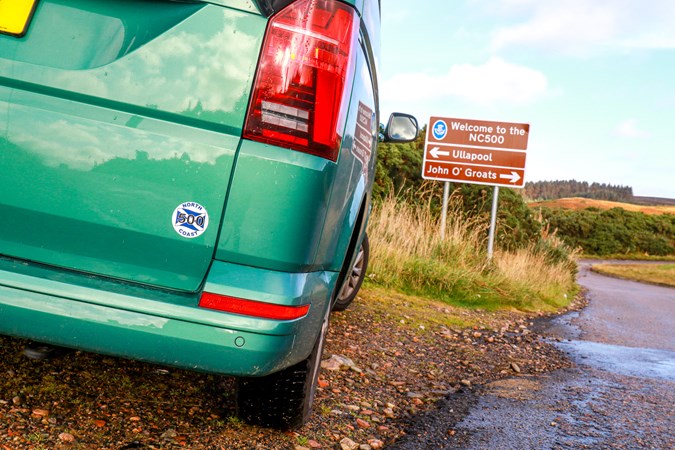
As you might have guessed it’s 500 miles long and at times consists of very narrow roads in rugged and remote terrain, so getting round the route is more challenging and time-consuming than the 500 or so miles up the A1 from Peterborough.
How long does the NC500 take?
You can actually complete that transfer in a single day, while the route itself is best enjoyed at a slower pace, usually limiting the daily distance to 100 miles maximum. Not only would you miss out on the views by going quicker, but there are plenty of things to stop and do along the way that you won’t want to rush.
These range from natural attractions like waterfalls and caves to historic castles and forts. Then there are the touristy bits you feel like you need to tick off even if just to get the perfect holiday selfie.
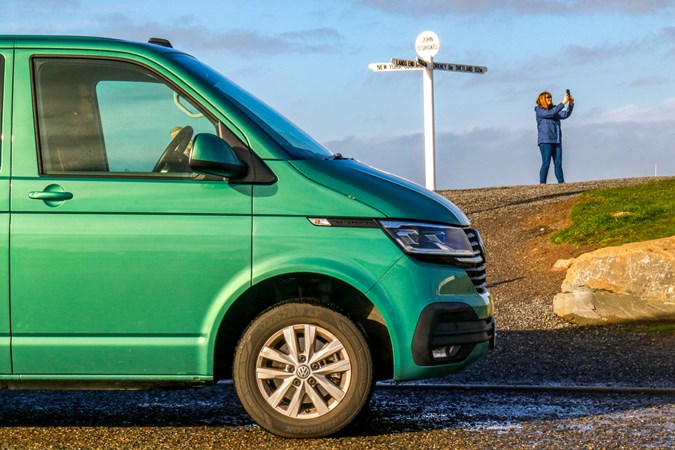
When you get to Inverness the signposts for the NC500 commence and are present along the entire route. Not keen to rely soley on those, we used the VW’s sat-nav each day and programmed a route town-to-town.
We also brought along a paper NC500 map in order to check the plan on the screen followed the proper way, as they usually like to cut corners.
In the height of summer when the route is busiest it’s best to drive it in the traditional clockwise direction, up the west coast first, then along the north coast, and then the east. Quite a lot of the roads are single track, and if you go anti-clockwise, you’ll spend the entire time giving way to a stream of motorhomes. These are numerous and enormous and not keen on giving way.
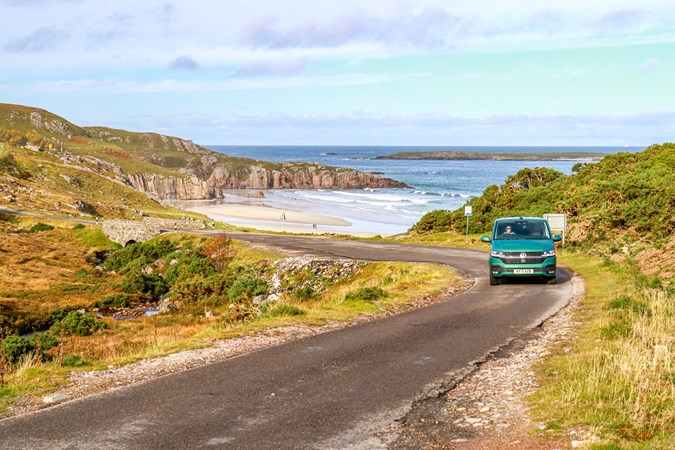
But we were visiting in autumn when it’s quieter, just after midgey season (genuinely worth avoiding, unless you like being swarmed with flies) so traffic wasn’t likely to be an issue.
The main reason though was the timing of our ten-year wedding anniversary (did I mention this is why we were doing the NC500?) which fell late into our trip schedule, so we decided to go anti-clockwise and celebrate on the west coast. No shade to the rest of Scotland, but that’s my favourite bit.
What is the best vehicle to drive the NC500?
A few years ago when I was running a Ford Focus RS long termer I’d have said that. I actually planned an NC500 trip in that car but for various complicated reasons I won’t bore you with I had to cancel my trip, and my colleague Keith Jones went instead, so I blocked him on social media for the week. But the good news is I’m no longer bitter about it. At all.
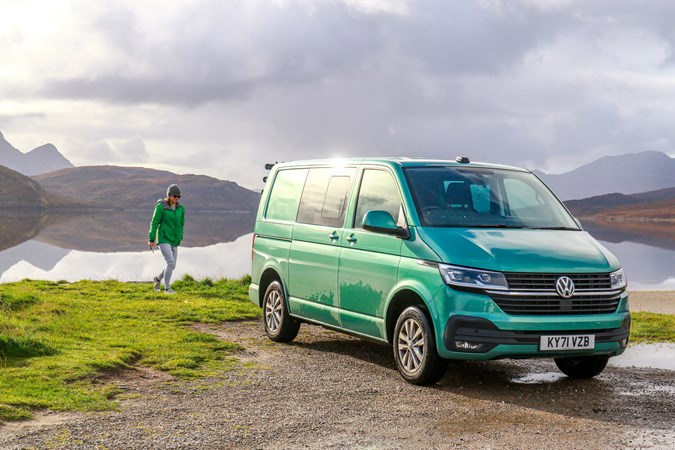
Now I’d say something like a Toyota GR Yaris or Porsche Cayman GT4 – it needs to be small and nimble ideally and capable of coping with changeable weather. But that’s if I was doing the NC500 alone, rather than with my wife, and that changes things completely.
Drive anywhere in a fast car and the temptation is to drive it quickly, all the time. Lay down a rollercoaster ribbon of undulating tarmac across a visually arresting landscape and that temptation is multiplied. A brilliant experience for me, an uncomfortable nausea-fest for a passenger, especially over the course of six days.
Also, while there are fabulous flowing open sections, there are also some super tight single lane roads with so much gradient change it feels more like off-roading, where even a Suzuki Jimny would feel big. Still fancy taking that V12 supercar? Only if you have a garage full of spare side skirts and wheels.
Is this another excuse for you to say something about vans being better than cars?
Look – if I was going by myself then a small overnight bag with one change of clothes would suffice. I’d just wash whatever I was wearing that day in the hotel sink and then dry it in the car the next day, like I would on a motorcycle tour. But this sort of behaviour is not compatible with romantic travel.
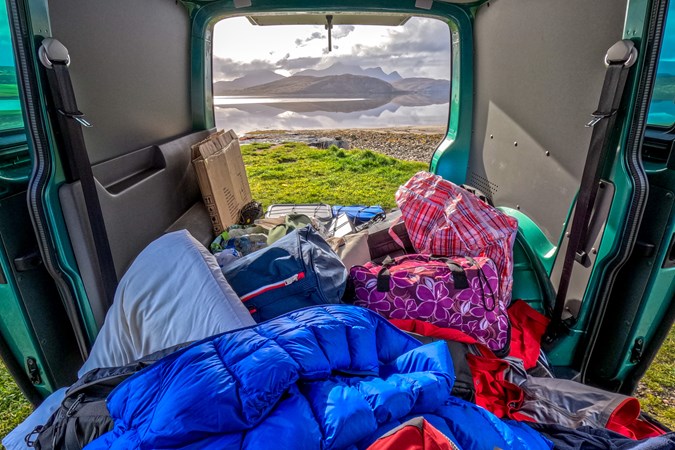
Lots of people complete the route in a camper van. This sounds fantastic but also quite hard work, having to set up camp every night. A motorhome is less manual labour but they’re too big for most of the route and in fact not allowed on some parts of it.
So a car is too small. Campervan, a faff. Motorhome, too big. Transporter Kombi? Just right. With the back seats removed we had ample space for every conceivable thing we’d need, up to and including a couple of paddleboards, and an inflatable bed should we need to camp in it in an emergency.
When are you going to explain that camel comparison?
The perfect NC500 vehicle is a weird mish-mash of requirements – we’ve covered off the size sweet-spot above, but from there it just gets more complicated.
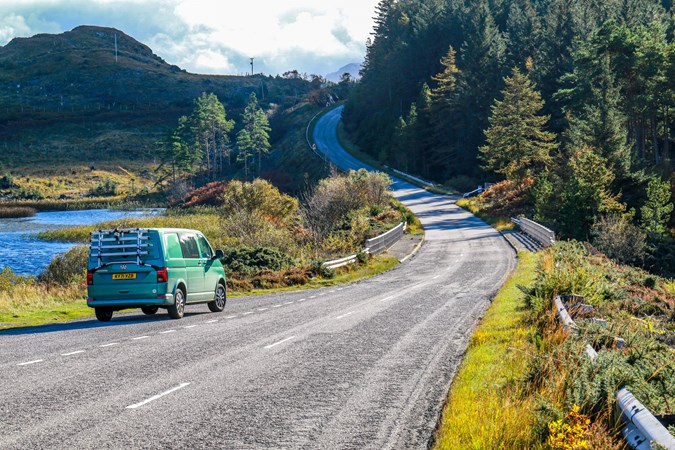
You’re going to spend a lot of time behind the wheel, so comfortable seats are an absolute must. Luckily the Transporter’s chairs offer genuine all-day support and even feature an armrest for each arm. Decent suspension comes a close second, as there are plenty of rough roads and crashing over them on hot hatch springs is going to get boring quickly.
Range is super important – there are fuel stations on the NC500 but they can be quite spaced out, so you don’t want a racing tank that needs topping up every 200 miles. The (optional) 80-litre tank in the van means a theoretical range of about 600 miles. We could technically fill up in Inverness and then not have to worry about fuel again until the end.
Another consideration is height, both vehicle and driver. Plenty of switchbacks and lumpy roads means decent ride height is essential and sitting up that bit taller gives you a much longer view down the road over hedges and suchlike. There are passing places on the singletrack roads and the further you can see into the distance, the better chance you have of spotting an oncoming vehicle and pulling over. Nobody likes reversing down a track flanked by prehistoric peat bog.
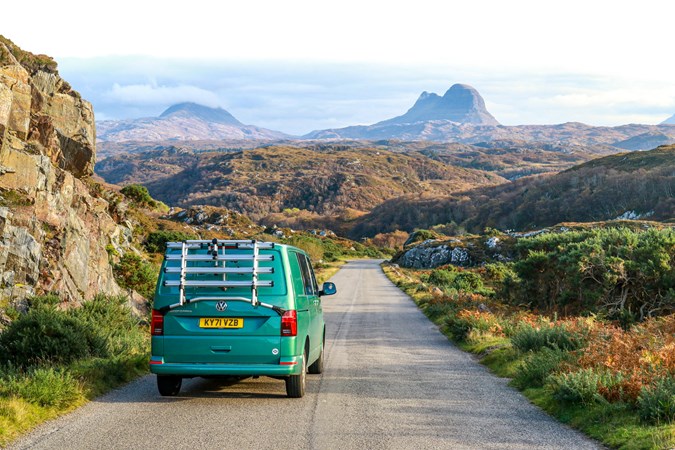
Storage up front is a must, you’re going to be half-living in this vehicle so it needs somewhere suitable to store a camera, lunchbox or charging phone. While the Transporter doesn’t have a huge number of cubbies it does offer a vast dashboard full of storage and a big space between the driver and passenger to pile stuff up.
There must be some downsides…
Always, but they’re definitely in the minority. First up is the fact you’re in a van, and if it’s a colourful one like mine with a bike rack on the back, even worse, because you’re basically advertising the fact you’re a tourist. I may have compounded this by putting an NC500 sticker on the tailgate.
That aside, I’ve never found the USB socket or either of the 12v outlets particularly good at charging my phone in the Transporter. I don’t know what the deal is with this but when you’re out all day in the wilderness with no-one but Highland cows for company and relying on your phone for directions or information, this can be an issue. Pack a powerbank.
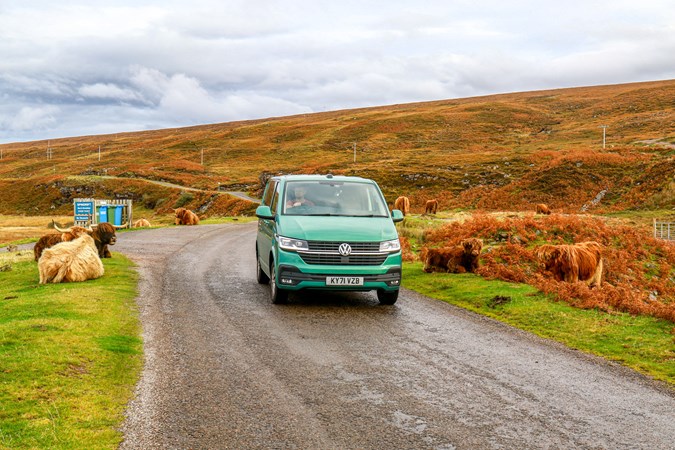
The stereo only has speakers in the front and this makes it a bit weak, particularly if you’re listening to a podcast or audiobook. We listened to The Hobbit in its entirety, which I can definitely recommend as a pairing to the Scottish scenery, and it was pretty hard to make out the words at times.
There’s the lack of cupholders, which I’ve complained about before, and this is even more annoying when you’re spending all day in a van and have anything more than a basic need for hydration.
We had one each and in fairness this should be enough, but they’re too close to the windscreen and this often resulted in an annoying tap-tap-tap of my Irn Bru lid attempting Morse code.

Same goes for the manual air con – not normally an issue, but when you have to fiddle with it again and again to get it right for the third day in a row, it’s pretty bothersome.
What was the NC500 like?
I’ve not really mentioned it because this is principally a car website rather than a travel one, but frankly, you’ll have a good time in whatever vehicle you choose. Scotland (particularly the west coast) is home to hands-down the most breathtakingly beautiful countryside in the UK, maybe even the world.
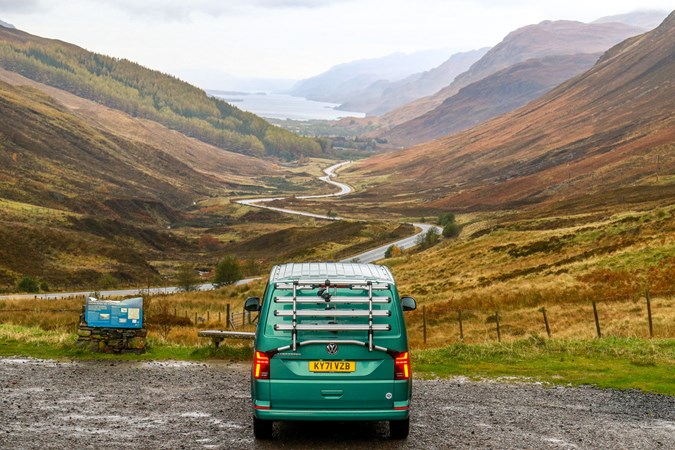
This point really drives home when you spend day after day in it, because just visiting for a short time only gives you a snapshot. We had whole days where the view out the window was relentless gorgeous, with absolutely no let up from the first mile to the last.
Sometimes you’ll be driving on roads that sweep and rise like a rollercoaster, surrounded by scenery that makes it very difficult to concentrate. The next minute you’ll be on an intestinal mountain pass that requires every square inch of your focus.
We paddleboarded with seals, camped overnight in a crofter’s wagon, and watched the sunset on a beach so remote and untouched by other humans it could have been on an alien planet. With the larger settlements of the east coast in our mirrors, the windscreen became a cinema to an extended director’s cut of mother nature’s greatest hits. Just scene after scene of massive, epic landscape.
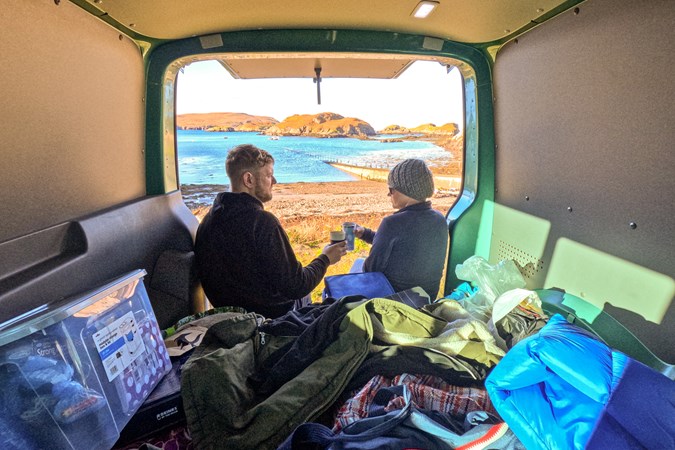
And while living on the road and sleeping in a different hotel room every night is an adventure, it can be isolating and homesick inducing too, even when there’s two of you. Waking up every morning and getting into the bit of home we brought with us had a huge impact. It was the perfect vehicle, really.
I would still quite like to do it in a Ford Focus RS though.
Update 7: Farewell
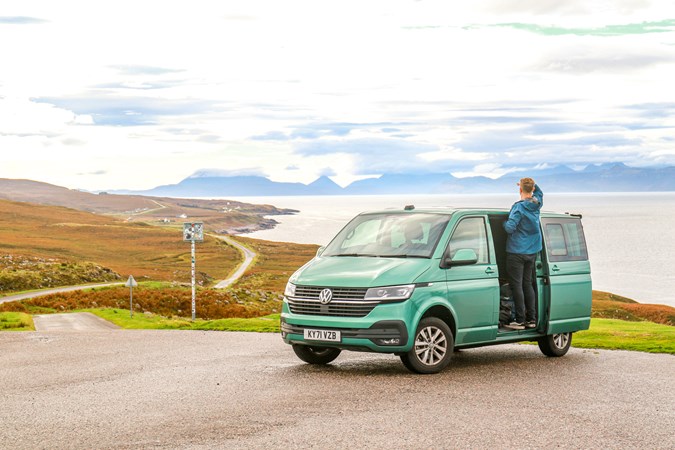
All good things come to an end and it’s time to take stock of how well the VW Transporter functioned as a family car
I started this long term evaluation of the VW Transporter Kombi by setting out why I thought it would be as close to the perfect family vehicle (for me) that it was possible to get.
Now, plainly that’s quite a divergence from its intended purpose, which is to move heavy equipment and people from one construction job to the next.
But when you break down the requirements for a family car, are they so different from a commercial vehicle’s? Surely those core values are pretty interchangeable, except with bikes and pushchairs instead of generators and two by four, and soft-play centres instead of building sites.
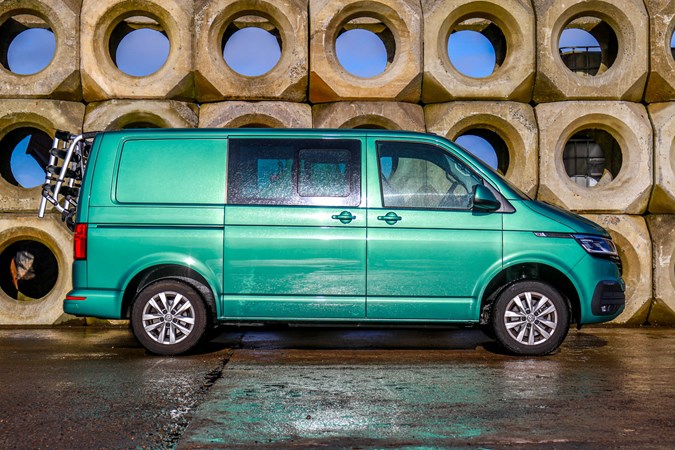
My induction into van life came via CJ’s Ford Transit Custom that I borrowed in 2022. It won me over, hard, with its enormously practical load area and generous crew space. But as I said at the time, it was a bit industrial, and didn’t have enough airbags.
The Transporter aims to offer a more carlike experience, thanks to its proper rear suspension and more luxuriously appointed interior. Mine also had more airbags, but it’s worth saying those were optional extras.
Normally you can’t have a truly stylish and practical vehicle – one or either will be compromised by the other, but I think VW has done a great job in homogenising the commercial and lifestyle variants of this van. The Sportline trim in particular looks absolutely epic.
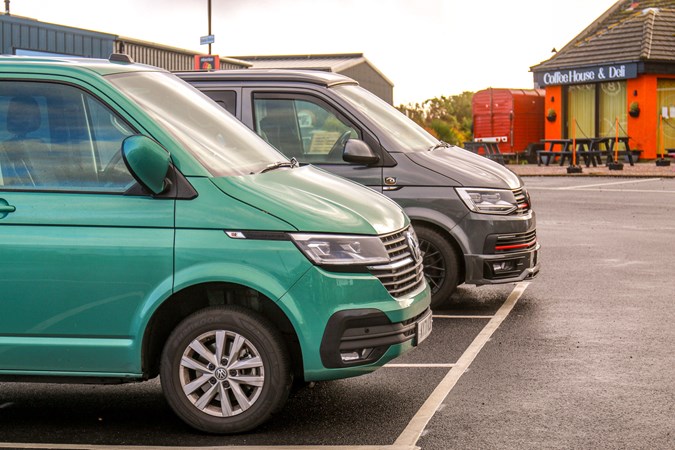
And yet despite all this the base vehicle is one capable of moving vast amounts of kit, whether as Luke’s removal van or the entire concert stage that Tom packed inside it.
For us it was usually full of bikes, and from the first time I loaded my mountain bike diagonally into the load bay, with both wheels on and room to spare, I was hooked.
The hard-mounted tailgate rack also came in useful multiple times, as did the removable roof rack bike carriers, although those are a little harder to access on such a tall vehicle.

The rear bench was so huge my kids could stretch out without having to interfere with each other, and the position of it came with the added bonus of them not being able to reach us in the front seat either.
It sounds like a minor thing but not being tied to having my youngest sitting behind me and my eldest behind my (shorter) wife made life much simpler. Now they could just sit where it was most practical, and if my wife and I swapped over driving mid-journey, it didn’t matter.
And although it was probably a two person job, the whole seat could be removed leaving an enormous space, perfect for transporting gardening or building supplies, or simply going on holiday.
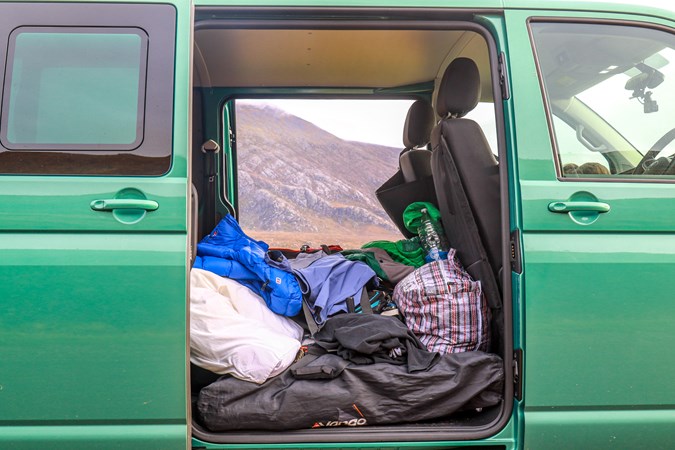
I’ve not spoken much about the way the Transporter drives and this is for a good reason – it was completely unremarkable, in the most positive way possible.
The 2.0-litre, 150hp diesel engine and DSG automatic gearbox just got on with the job in a quiet and fuss-free way. It wasn’t supercar fast, but it wasn’t annoyingly slow either, it was just right.
From a handling perspective it was always best when loaded up with weight (like most vans) but even empty the bodyroll and steering were very carlike and easy to live with.
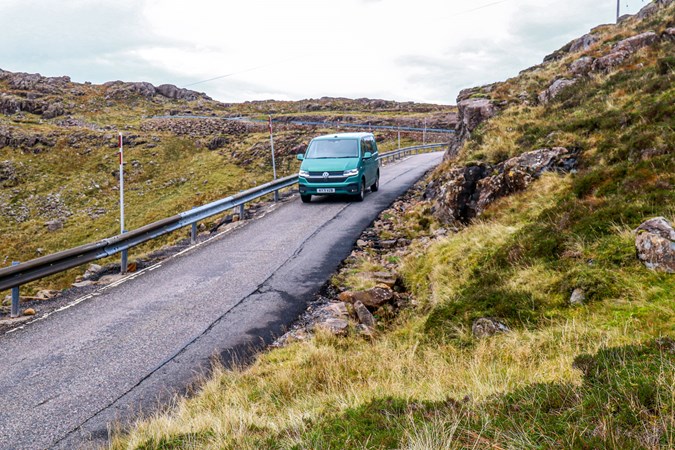
Some downsides then – my youngest child wasn’t strong enough to close her sliding door, and the seatbelt was too far away for her to reach.
It annoyed me that the mirrors didn’t fold in automatically (you have to hold the lock button) and manual air con stuck out like a sore thumb in an otherwise pricey vehicle.
The interior was very nice for a commercial vehicle and perfectly functional, but lagging behind what you’d expect in a car of equivalent value. Hopefully this is something VW will fix in the next Transporter van.
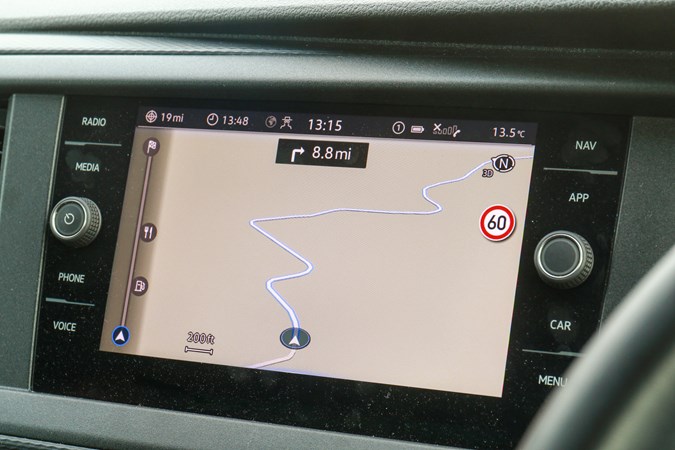
There isn’t exactly an abundance of interior storage space either – well, there’s plenty of room, but it was crying out for some sort of under arm box or even some covered cubbies in the dash.
I also think it’ll be overkill for most – unless you need to carry a europallet or a tonne of rubble you won’t get near the Transporter’s capability. In which case, something like a Caddy Life is probably better, with slightly less commercial capability but a much more modern interior.
Other than that the Transporter slotted straight into our lives so well at times I forgot it wasn’t actually mine. When the man came to take it away I was half-tempted to tell him I’d lost it and he couldn’t have it.
People told me learning to ride motorbikes would ruin cars – not true. It certainly didn’t help, but the VW Transporter was the final nail in the coffin. Want a family car for your big hobbies? Get a van.
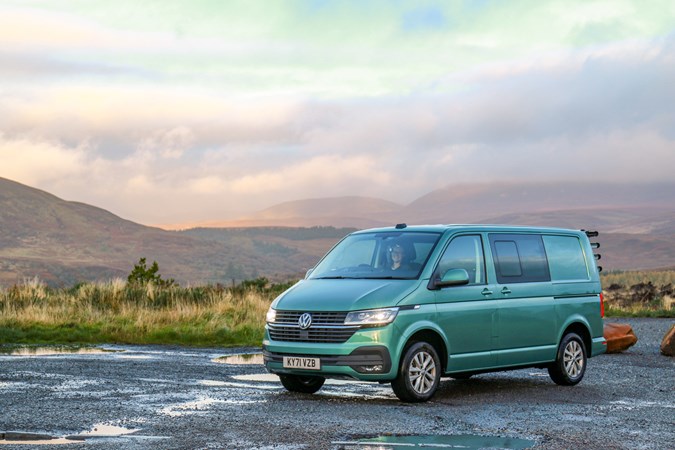
Just so you know, we may receive a commission or other compensation from the links on this website - read why you should trust us.


